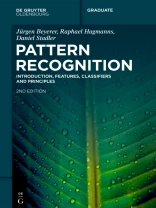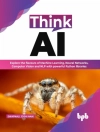The book offers a thorough introduction to Pattern Recognition aimed at master and advanced bachelor students of engineering and the natural sciences. Besides classification – the heart of Pattern Recognition – special emphasis is put on features: their typology, their properties and their systematic construction. Additionally, general principles that govern Pattern Recognition are illustrated and explained in a comprehensible way. Rather than presenting a complete overview over the rapidly evolving field, the book clarifies the concepts so that the reader can easily understand the underlying ideas and the rationale behind the methods. For this purpose, the mathematical treatment of Pattern Recognition is pushed so far that the mechanisms of action become clear and visible, but not farther. Therefore, not all derivations are driven into the last mathematical detail, as a mathematician would expect it. Ideas of proofs are presented instead of complete proofs. From the authors’ point of view, this concept allows to teach the essential ideas of Pattern Recognition with sufficient depth within a relatively lean book.
O autorze
Prof. Dr.-Ing. Jürgen Beyerer has been a full professor for informatics at the Institute for Anthropomatics and Robotics at the Karlsruhe Institute of Technology KIT since March 2004 and director of the Fraunhofer Institute of Optronics, System Technologies and Image Exploitation IOSB in Ettlingen, Karlsruhe, Ilmenau, Görlitz, Lemgo, Oberkochen and Rostock. Research interests include automated visual inspection, signal and image processing, variable image acquisition and processing, active vision, metrology, information theory, fusion of data and information from heterogeneous sources, system theory, autonomous systems and automation.
Raphael Hagmanns graduated with a master’s degree in computer science at the Karlsruhe Institute of Technology (KIT) in 2020. Since this year, he has been pursuing his Ph.D. at the Vision and Fusion Laboratory under Prof. Beyerer’s supervision. He conducts research in the fields of mobile robotics and computer vision, particularly on semantically informed mapping and inspection systems for robotic systems in unstructured environments. His research work is carried out in close collaboration with the Autonomous Robotic Systems Group at the Fraunhofer Institute of Optronics, System Technologies and Image Exploitation (IOSB), where his methods are employed in the field of decontamination robotics. Hagmanns is the author of different scientific publications and datasets, for notable examples being the GOOSE dataset for semantic segmentation in unstructured environments.
He has also been involved in the organization of conference workshops on unstructured scene understanding and contributed various talks in workshops at renowned conferences.
Together with Daniel Stadler, Hagmanns has been supervising the pattern recognition lecture at KIT for several years and has co-authored the second edition of the book on the lecture, which was published in 2024.
Daniel Stadler completed his master’s degree in electrical engineering and information technology at Karlsruhe Institute of Technology (KIT) with distinction in 2019. He then joined the Vision and Fusion Laboratory of KIT to pursue his Ph D under the supervision of Prof. Jürgen Beyerer. His main research topic is multi-object tracking in 2D videos, on which he has published a dozen of scientific papers at top computer vision conferences including CVPR, ECCV, and WACV. Currently, he is completing his Ph D thesis that focuses on improving the use of available information in multi-person tracking.
Stadler also works in close collaboration with the Fraunhofer Institute of Optronics, System Technologies and Image Exploitation, where he develops detection and tracking methods for various applications ranging from aerial traffic analysis to maritime person search. With his team, he won the honorable mention for the third place in the Vis Drone 2020 Multi-Object Tracking Challenge and achieved the second place in the 2024 Maritime Computer Vision UAV-based Multi-Object Tracking with Re ID Challenge.
In 2024, Stadler co-authored the second edition of the textbook 'Pattern Recognition’, which is based on the eponymous lecture of Prof. Beyerer at KIT that he co-supervises.












